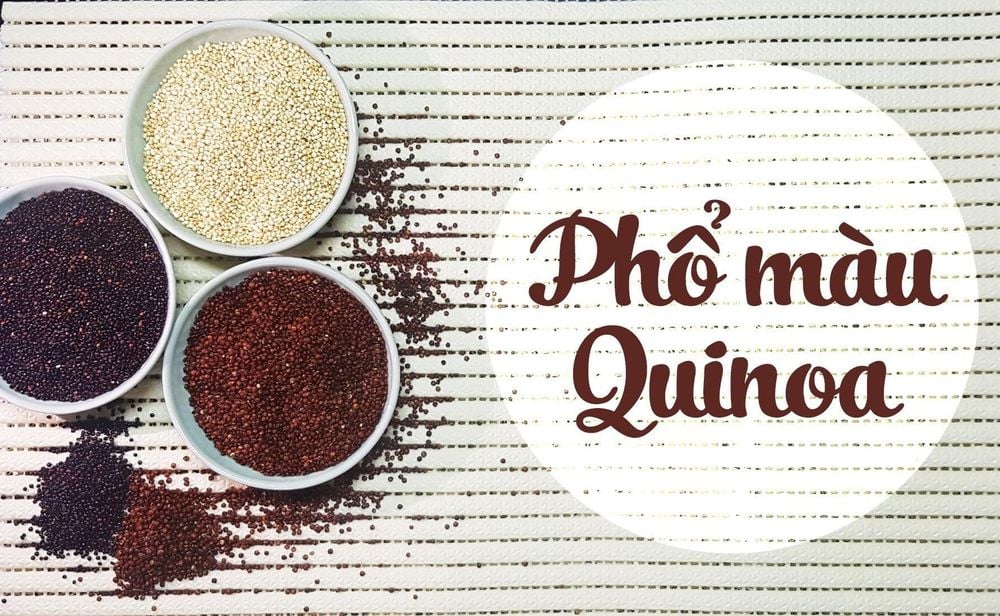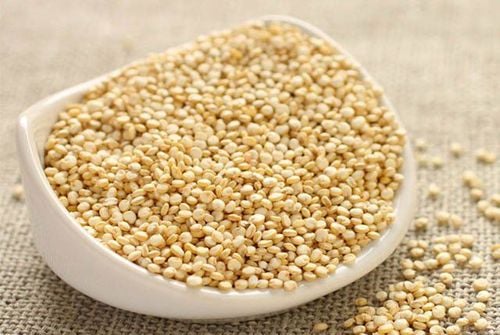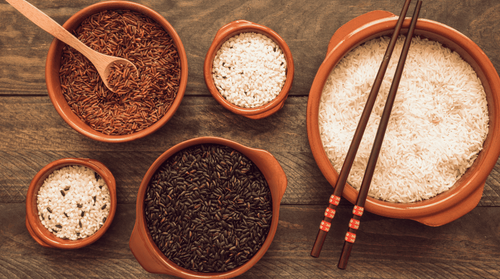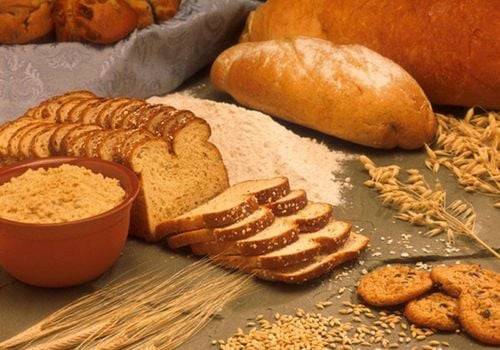This is an automatically translated article.
Quinoa is known as the ancient South American grain that has been largely ignored for centuries. Interestingly, quinoa has only recently been noticed by the rest of the world and hailed as a “superfood” due to its high nutritional content. Today, quinoa is considered a delicacy by foodies and health conscious people. This article will provide more detailed information about this seed.
1. What is Quinoa?
Quinoa (pronounced KEEN-wah) is the seed of the quinoa plant Chenopodium. Scientifically speaking, a quinoa seed is not a grain. However, quinoa is often referred to as "pseudograin" because it has similar nutrients and is eaten in the same way as whole grains.
Is quinoa good? Quinoa was virtually unknown to the rest of the world until very recently. Since then, quinoa has gained popularity because of its high nutrient content and health benefits. quinoa is also easy to grow in a variety of conditions.
Quinoa is also very popular because quinoa belongs to the group of gluten-free grains. This means that people with celiac disease, wheat allergies or those who avoid gluten can consume this grain.
2. Types of Quinoa
There are more than 3,000 varieties of quinoa. However, the most commonly grown varieties of quinoa are red, black, and white. Quinoa can also be flaked or ground into a powder, which can then be used for cooking and added to baked goods.
White quinoa is the most commonly consumed, however different types of quinoa also have different nutrient content.
A comparative study of red, black, and white quinoa found that while black quinoa had the lowest fat content, this seed had the highest content of omega-3 fatty acids and carotenoids. The vitamin E content of red and black quinoa is twice as high as that of white quinoa. The study also analyzed the antioxidant content of each and found that the darker the color, the higher the antioxidant capacity.

3 loại hạt quinoa được trồng phổ biến nhất là đỏ, đen và trắng
3. Nutritional composition of quinoa seeds
Quinoa contains many nutrients. Quinoa is packed with vitamins and minerals, and contains more protein, fiber, and healthy fats than other grains.
185 grams of cooked quinoa includes:
Manganese: 58% of the RDI. Magnesium: 30% of the RDI. Phosphorus: 28% of the RDI. Folate: 19% of the RDI. Copper: 18% of RDI. Iron: 15% of the RDI. Zinc: 13% of the RDI. Thiamine: 13% of the RDI. Riboflavin: 12% of the RDI. Vitamin B6: 11% of the RDI. One cup of quinoa provides 220 calories, in addition to 8 grams of protein, 4 grams of fat and at least 5 grams of fiber.
3.1. Quinoa contains complete protein
Protein is made up of amino acids, which can be made by your body or found in certain foods. Complete proteins contain all nine essential amino acids. While all animal protein sources are complete, most plant proteins are not. The ingredient quinoa contains complete plant protein, which is one of the exceptions. While the body can get all the essential amino acids from a plant-based diet, it requires a variety of protein intake.
3.2. Quinoa contains beneficial plant compounds
Quinoa is rich in plant compounds that have health benefits. Some examples are saponins, phenolic acids, flavonoids, and betacyanins. Many compounds can act as antioxidants to help neutralize free radicals that damage your body at the molecular level.
One study examined 10 grains from Peru. The results found that quinoa seeds had an antioxidant capacity of about 86%, higher than all other grains analyzed. In addition, the study found that as with all quinoa nuts, which are high in antioxidants, that includes darker nuts with higher antioxidant levels. This means that black quinoa seeds contain more antioxidants than white seeds.
Additionally, sprouting quinoa seeds can increase the antioxidant content even further. However, high antioxidant capacity in the laboratory does not necessarily translate into higher antioxidant capacity in the body.
3.3. Quinoa contains several antinutrients
Saponins, phytic acid and oxalates are the most common antinutrients found in quinoa. However, quinoa is very well tolerated by the body and this antinutrient is not a major concern for the average person with a well-balanced diet.
Saponin
Saponin is both positive and negative. Saponins have beneficial antioxidant and anti-inflammatory effects. Some saponins have even been shown to help lower blood cholesterol levels. However, saponins also have a bitter taste and can prevent the absorption of certain minerals, such as: Zinc and iron. To reduce the saponin content in quinoa seeds can be applied by washing, scrubbing with water or soaking in water.
Oxalate
Oxalate is commonly found in plant foods like: Spinach, rhubarb and buckwheat. Oxalate can reduce the absorption of some minerals and may bind with calcium to form kidney stones.
Although oxalates pose no problem for most people, people who are prone to developing these types of kidney stones may want to avoid foods high in oxalates.
Phytic Acid
Phytic acid is found in many foods, including nuts and grains. Phytic acid is an antioxidant and may prevent the formation of kidney stones. On the other hand, this acid can also block mineral absorption, which can increase the risk of deficiency in an unbalanced diet.
4. Benefits of quinoa
4.1. Quinoa may improve blood sugar control
Quinoa is considered a whole grain. Several studies have found benefits of linking whole grain intake to a reduced risk of type 2 diabetes and improved blood sugar control.
One review study found that consuming just 16 grams of fiber from whole grains per day can reduce the risk of developing type 2 diabetes by 33%.
Quinoa also contains compounds that inhibit alpha-glucosidase , one of the enzymes involved in the digestion of carbs. This can delay the breakdown of carbs, causing a slower release of glucose into the bloodstream.
Quinoa's high fiber and protein content may also contribute to its positive effects on blood sugar. However, it is a grain and is still relatively high in carbs.
4.2. Other health benefits
May improve metabolic health
Quinoa, a good choice for people with high blood lipids (cholesterol and triglycerides). One study found that eating 50 grams per day for 6 weeks reduced total cholesterol, triglycerides, and LDL cholesterol. However, these effects are very small and it also lowers HDL cholesterol levels.
Other studies have compared quinoa and fine corn. The results showed that quinoa alone significantly reduced triglycerides, total cholesterol, and LDL cholesterol.
These studies are preliminary, but still show that quinoa can help improve metabolic health.
May help fight inflammation
Chronic inflammation is linked to a variety of diseases, from type 2 diabetes to cancer and heart disease.
Although studies have not shown consistent results, a diet rich in antioxidants is thought to help fight inflammation in the body.
Saponins, one of the plant compounds found in quinoa. They give it a bitter taste, and some people wash or soak the quinoa seeds to try and remove this taste. However, saponins also have some positive effects. In addition to acting as antioxidants, saponins also have anti-inflammatory effects.
One study showed that saponins could inhibit the production of anti-inflammatory compounds by 25–90% in isolated cells.

Hạt diêm mạch cũng có thể có lợi cho sức khỏe trao đổi chất, chống viêm và hơn thế nữa.
5. How to Use Quinoa
Quinoa is very easy to process, can be made into products: Instant quinoa or baby quinoa. At the same time, this nut also has a nutty flavor and a chewy, smooth texture. You can cook quinoa just like rice, with two parts liquid and one part quinoa. Quinoa is known as a delicious whole grain that is packed with nutrients, fiber, protein, and plant compounds. Quinoa has a unique flavor and is an easy way to add variety to your diet. Quinoa is especially great for vegans, vegetarians, and those on a gluten-free diet. However, its impressive nutrient profile and health benefits make quinoa a great addition to any diet.
Please dial HOTLINE for more information or register for an appointment HERE. Download MyVinmec app to make appointments faster and to manage your bookings easily.
Reference source: healthline.com













